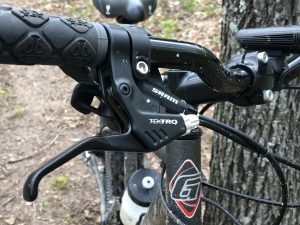Gravity Bullseye Monster Long-term review
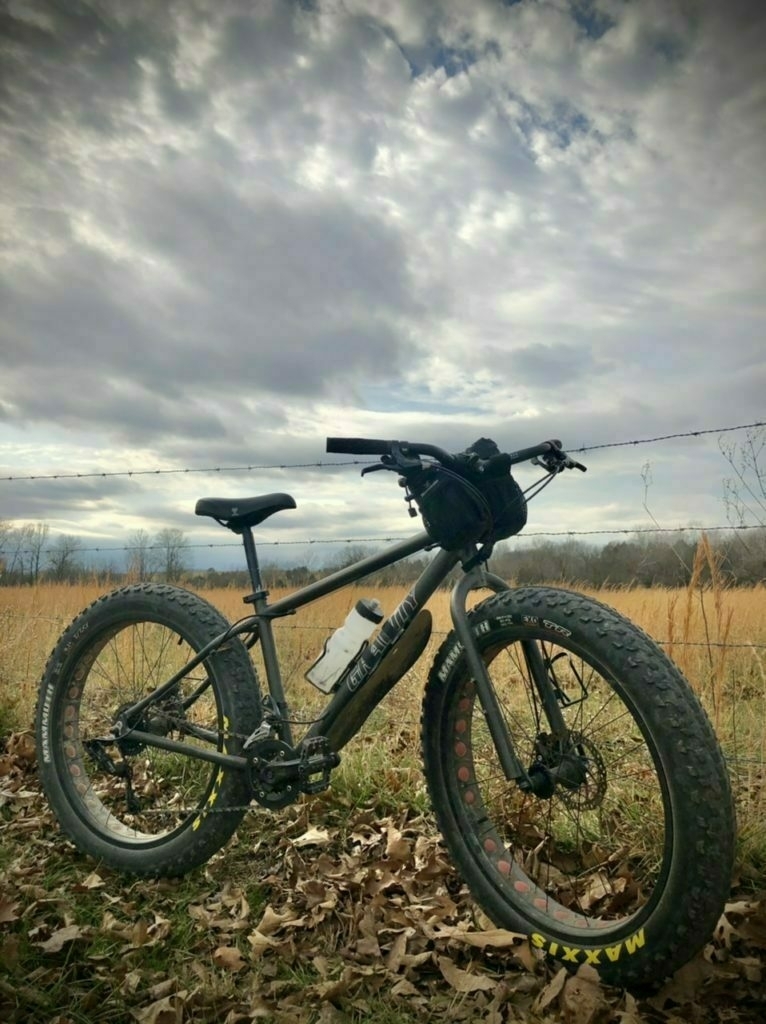
Back in mid-April, I purchased a Gravity Bullseye Monster (what a terrible name for a bike, I’ll abbreviate as GBEM!) from Bikes Direct. I’d written up a brief initial impressions post after riding it for a week or so. Since that time I’ve shared many photos and various mentions of my fat bike rides but never followed up with a proper review. With my knee problem now (apparently and hopefully) solved I’ve been back on the fatty for a couple weeks of daily trail riding and it occurred to me to check my mileage on the bike: a bit over 2,200. So, yeah, time for a long-term review.
I’ve made no secret of my love for this bike. Truth is, I’d likely love riding any decent fat bike but this is the one I have so it’s what I’ll be writing about. Of the miles I’ve put on the bike I’d estimate that about 55% were road miles, 10% gravel and 35% trail. While many fat bikes are bought for use on snow I bought mine for year-round trail riding. In the late 90’s I’d done a good bit of riding on various mountain bikes, aluminum and steel, most with front shocks. Of course, fat bikes are a relatively new thing and while many people are still riding mountain bikes, I went with fatty for a few reasons:
- The ride felt cushy enough without shocks, including the rear wheel.
- 4” Fat tires are forgiving in a way that 2.5” mountain bike tires are not. Which is to say, they roll over things that a mountain bike tire might catch on.
- The fat tire experience provides for a kind of slow, casual trail ride. Sure, I can go fast, but the fat tire form factor almost suggests a slower ride which appeals to me. Almost like a beach cruiser for the woods!
So, getting on with the review of the GBEM, I’ll get the negatives out of the way first.
This is a budget bike which sells for $499 to $599 so that means it’s got some compromises (actually, I’m cooking up a separate post about budget bikes and direct consumer bikes as compared to the name brand, more expensive bikes found at bike shops). That said, only three specific components really stood out to me as worth mentioning as negatives: the pedals, handlebar and the chain.
[caption id=“attachment_1803” align=“aligncenter” width=“900”]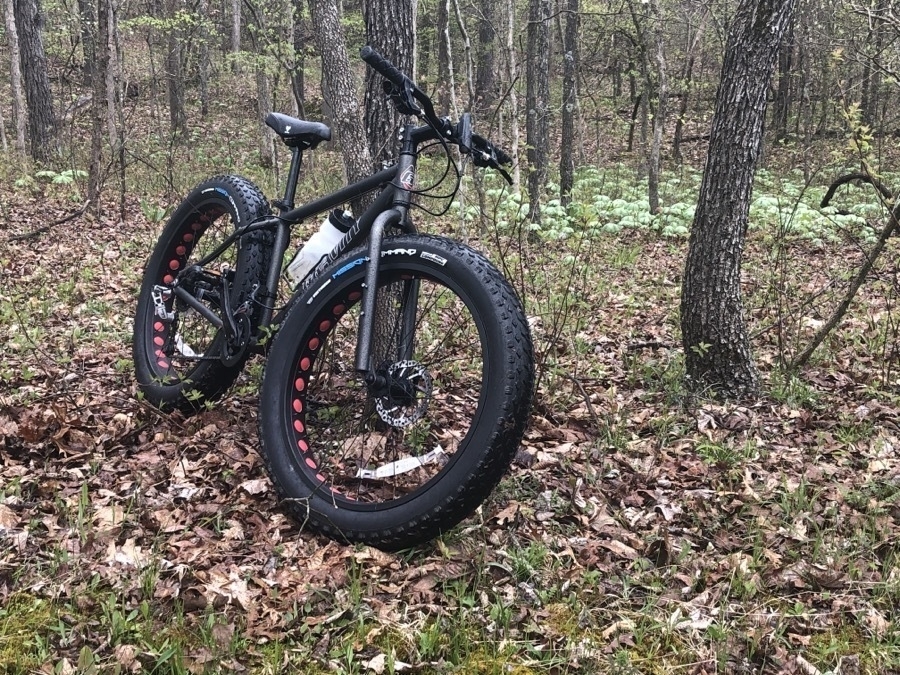 The stock configuration of the bike with just a water bottle cage and light attached.[/caption]
The stock configuration of the bike with just a water bottle cage and light attached.[/caption]
I changed the pedals within the first week. Not much to say about the pedals other than they are just cheap pedals fine for a casual ride around the neighborhood or occasional trail ride. It’s assumed many riders will replace the pedals anyway, the stock pedals are there so that it’s a functional bike out of the box. I replaced them with Rock Bros platform pedals which have worked well. They could probably ship with a slightly better, wider plastic composite platform pedal that would work for some people without a change. In fact, these platform pedals are the pedals that ship on the Poseidon X and I’m still using them on that bike with no problem.
The handlebar, 620mm, is really too narrow a bar to be the default. It works but should be a bit wider. But on many new bikes, like the pedals, it is assumed they will be changed by more “serious” riders. I changed it out to an Origin8 Space Off Road II Handlebars. Still, would be nice if they started the bike with a wider handlebar.
The chain included with the GBEM was a fairly cheap chain that should have been replaced at about 1,300 miles. I forgot to check wear until I hit the 2,000 miles mark. I let it go too long and as a result also had to replace the rear cogs too. My bad. I should have started checking for wear at about 1,000 miles. That said, a well cared for, quality chain on a bike that’s not being ridden hard might be expected to last 2,000 miles or more. That was the case for the chain on the Poseidon X which lasted well over 2,000 miles. Oh well. I’ve replaced the chain (a higher quality chain) and cogs and will be sure to stay on top of chain wear this time.
Some nitpicks that don’t affect the ride quality but I think are worth mentioning.
- The stem has a 2 bolt, handlebar clamp size of 25.4, both of which are old standards. More modern stems are 4 bolt attachments and have a clamp size of 31.8. When I upgraded the handlebars I should have also upgraded the stem to the modern standards. Oh well.
- The head tube is not tapered which limits fork upgrades. Not a deal killer as I don’t intend to upgrade my fork but again, worth mentioning for others that might not be aware of the issue.
- The seat post paint scratches off instantly with any kind of adjustments or post movement. Also, no height indicators on the post. It’s a cheap post so not surprising.
- Front wheel foot strike! Common to a lot of these bikes is that when turning the front wheel, you may hit it with the toe of your shoe as you pedal.
That’s it for the specific component related negatives.
The rest is generally positive.
The brakes and drive train have performed fairly well. They were pretty well set out of the box.
The Tektro mechanical brakes are fine for me. They may not have the smooth modulation associated with more expensive hydrolic disc brakes but I suspect they are also easier to maintain. I’ve seen complaints online about the brakes but my hunch is that it’s often the case that buyers either are not adjusting the brakes that need adjusting or they are not given a little time to “bed-in”. These brakes, if properly set, should be able to lock-up the wheel when pulled fully. In that case it’s just a matter of learning how to operate them which is to say, careful modulation by the rider. They may never be as smooth as more expensive brakes but they do stop the bike very quickly if needed.
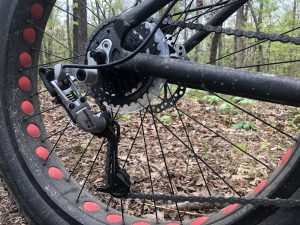 Moving onto the drivetrain, when I was replacing the cog set and chain I noticed that my rear derailleur hanger was very slightly bent (likely out of the box). I should have looked closer on initial set-up. When I bent it back I was able to change the limit screws a bit. Previously one was maxed out due to the bent hanger. I’d tweaked it when I set it up and didn’t realize the problem was actually the bent hanger. Anyway, the SRAM shifters and X4 rear derailleur have been fine. The Shimano Alivio front derailleur is good too. These are low-mid level components, so, not the best, but not bad. Perhaps heavier and slower to shift but nothing that has bothered me. The SRAM x4 trigger shifters work as expected.
Moving onto the drivetrain, when I was replacing the cog set and chain I noticed that my rear derailleur hanger was very slightly bent (likely out of the box). I should have looked closer on initial set-up. When I bent it back I was able to change the limit screws a bit. Previously one was maxed out due to the bent hanger. I’d tweaked it when I set it up and didn’t realize the problem was actually the bent hanger. Anyway, the SRAM shifters and X4 rear derailleur have been fine. The Shimano Alivio front derailleur is good too. These are low-mid level components, so, not the best, but not bad. Perhaps heavier and slower to shift but nothing that has bothered me. The SRAM x4 trigger shifters work as expected.
 It’s a 2x drive system with a generic crank, 22/32T chain rings and an 11-34T 8 speed cassette. I found this range to be perfect for the mix of riding I do: A bit of road, gravel, trail with short, punchy climbs on the trail. The lowest gear enables me to get up the steepest climb with no problem. For some riders that might have health issues or physical constraints a lower gear might be helpful on the trails but I think this range is good for most. All that said I think I’d prefer a 1x 10 speed on this bike. Similar to the Poseidon X but with a slightly lower gearing. The second chainring on a fat bike seems unnecessary given that it is likely going to be primarily ridden off road.
It’s a 2x drive system with a generic crank, 22/32T chain rings and an 11-34T 8 speed cassette. I found this range to be perfect for the mix of riding I do: A bit of road, gravel, trail with short, punchy climbs on the trail. The lowest gear enables me to get up the steepest climb with no problem. For some riders that might have health issues or physical constraints a lower gear might be helpful on the trails but I think this range is good for most. All that said I think I’d prefer a 1x 10 speed on this bike. Similar to the Poseidon X but with a slightly lower gearing. The second chainring on a fat bike seems unnecessary given that it is likely going to be primarily ridden off road.
 The WTB saddle, “Speed V Sport” is commonly seen on mountain bikes and fat bikes of this mid-range. It’s a pretty decent seat and I’ve got no complaints other than it’s a bit on the heavy side with a bit too much cushion but it’s a good choice for a starter bike for new cyclists might not ride all the time. I’m currently using the Charge Spoon saddle that I purchased for the Poseidon. The seat post is the same size so it was easy enough to swap it over and I’m used to the Spoon saddle so, why not?
The WTB saddle, “Speed V Sport” is commonly seen on mountain bikes and fat bikes of this mid-range. It’s a pretty decent seat and I’ve got no complaints other than it’s a bit on the heavy side with a bit too much cushion but it’s a good choice for a starter bike for new cyclists might not ride all the time. I’m currently using the Charge Spoon saddle that I purchased for the Poseidon. The seat post is the same size so it was easy enough to swap it over and I’m used to the Spoon saddle so, why not?
The wheel set is pretty typical at this price range. Hubs and rims are generic and on the heavier side though rims do have weight saving cut-outs. They were true out of the box and have stayed true for 8 months of riding so I’ll consider them fairly durable. They’re not tubeless ready or compatible which is fine with me as I’ve had no problem with tubes and slime. To my knowledge no tube punctures yet. I think the thick rubber of fat tires are pretty durable by default. I’ve ridden over a lot of thorny areas as well as brush-hogged fields full of very woody stems, creek beds with large rocks and no problems. Speaking of tires…
[caption id=“attachment_1778” align=“aligncenter” width=“625”]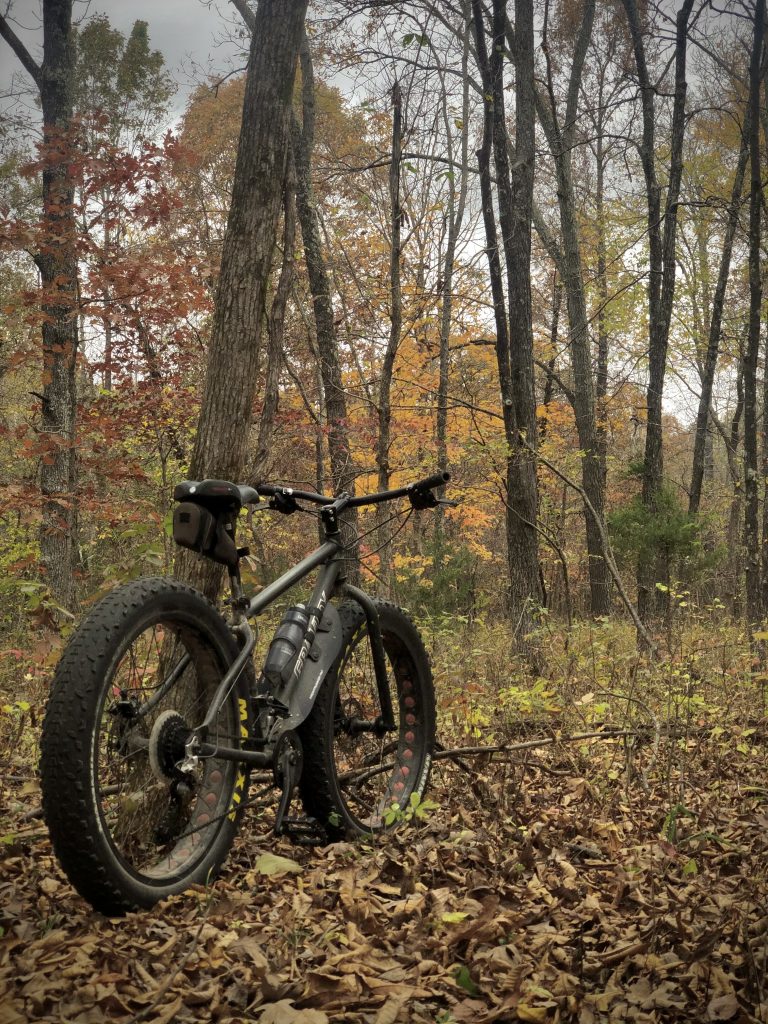 The bike with upgraded handlebars, tires and a few added accessories.[/caption]
The bike with upgraded handlebars, tires and a few added accessories.[/caption]
The GBEM comes with Vee Tire Co. Mission Command tires. Durable wire beads and bit heavy but a good overall tire to start with. I rode mine for a few months before I changed to a pair of Maxxis Mammoths. They’re a folding bead which means they’re a bit lighter, more supple with a solid center tread that rolls very well on pavement or trail. Given that I now have the Poseidon X to cover longer road/gravel oriented rides my next set of tires, Maxxis Minions, are more aggressive as I won’t have to worry about the smooth center tread for the little pavement I do on this bike. I’ve found in recent days that a layer of partially frozen sub-soil with a top layer of melted mud really creates an ice-like surface that the Mammoths slip on. I’ll likely post a comparison of these two tires in the near future. I mentioned above that they seem fairly thorn resistant and they should be, they’re expensive. Decent fat bike tires cost $90 for ONE tire. So, $180 (or more) for a pair. Yikes.
A few words about the frame and fork… it’s a 6061 aluminum frame and a cromoly fork. Nothing fancy here. There are lots of attachment points on the frame and fork. One set on the inside of the down tube, one on the outside. 1 set of 3 on each fork leg. That’s 4 possible water bottle cages or anything cages if I wanted to go camping and carry larger items. And plenty of mounting points for fenders or racks. I’d initially planned to skip adding any kind of rack but recently ordered one for the back. I do a lot of trail work and would like to have the option of toting tools out there. Also, it’s just generally convenient to have a rack and bungee cords for picking up packages or transporting anything that won’t fit in a backpack.
The overall bike as recently weighed with the above mentioned parts (no rack yet), was 38.4 lbs and that was with the front fender, bottle cages, water bottle/feeder bags. Which is to say that for a fatty it’s on the mid-upper end of expected weight. I’ll save detailed comparisons to more expensive bikes for a future post but for now I’ll just say that in this price range, a fat bike like the GBEM offers the rider a fairly easy and stable ride on trails that might normally cause problems on bikes with smaller wheels and tires. The fat tires just roll over things such as larger rocks, fallen branches or holes. I think they allow a rider to feel safer and more confident when encountering the things often found on a trail.
Related, another benefit of a fat bike (generally speaking) is the added traction for steep ascents and descents. Whether I’m riding on a gravel road or trail, assuming average conditions, I’m likely to feel like I’ve got good traction on the GBEM. Certain muddy conditions can eventually get a bit slippery but with the large tires a fatbike tends to provide solid footing. I really notice this when riding up steep hills with loose debris on the surface. Whether a loose gravel road or a trail with leaves, sticks, rocks, acorns, etc, a steep slope can often cause enough loss of traction to get you off the bike. The wide contact patch of the GBEM gives me the best chance of slowly peddling up and over these conditions. The steepest portion of my trail is a 13 to 14% grade, rutted hill with roots, leaves and fairly large rocks. It’s not easy but I make it up every time on the GBEM.
What about road riding? Well, a fat bike is definitely not a bike I would buy if I intended to mostly ride the road. Going forward the GBEM will be primarily a trail and gravel bike. That said, I put over 1,000 miles on our county roads in July and it works just fine. It’s heavier and has more rubber on the road than needed but it was much easier than I expected. In fact, when I switched to the much lighter gravel bike with much narrower tires I was surprised that my average speed and effort were not changed all that much! No doubt, the gravel bike is faster with less effort but I expected the difference to be greater than it actually was.
These bikes come 90% assembled. I took it out of the box, removed the packing materials, attached the handlebars, front wheel and pedals. I think that was about it. I checked the shifting and brakes and a quick once over to make sure everything was tight. Removing all the zip-tied packaging took about 20 minutes, the little bit of assembly and check-over took 40 minutes or so. I think most can handle it with the help of YouTube videos for the basics of adjusting derailleurs if need be. If not you can take it into a local bike shop. They’ll assemble and set-up for a fee. If you’re the sort that plans to maintain the bike on your own then you can learn as you need to assuming you don’t already have the skills. If you’re not going to maintain it then take it to a local bike shop as you’ll need to take it there in the future for tune-ups, etc.
[caption id=“attachment_1806” align=“aligncenter” width=“900”] The bike in it’s current configuration with multiple water bottle cages, handlebar attached bags, fenders and upgraded seat.[/caption]
The bike in it’s current configuration with multiple water bottle cages, handlebar attached bags, fenders and upgraded seat.[/caption]
As I said at the end of my initial review, I’d have no problem recommending this bike to anyone considering a fat bike. It’s on the heavier side with mid-level components but at 38 lbs it’s still a fairly light and easy ride on the trails. The GBEM sells for $500 to $600 and compares fairly well to bike store brands (Giant, Trek, Specialized, Salsa, Surly)which generally start around $1,500 and weigh in at around 33lbs. I’m working on a future post to compare these two general choices because it’s worth considering before purchasing a bike. That said, I’ll continue to ride my fat bike with no regrets.
